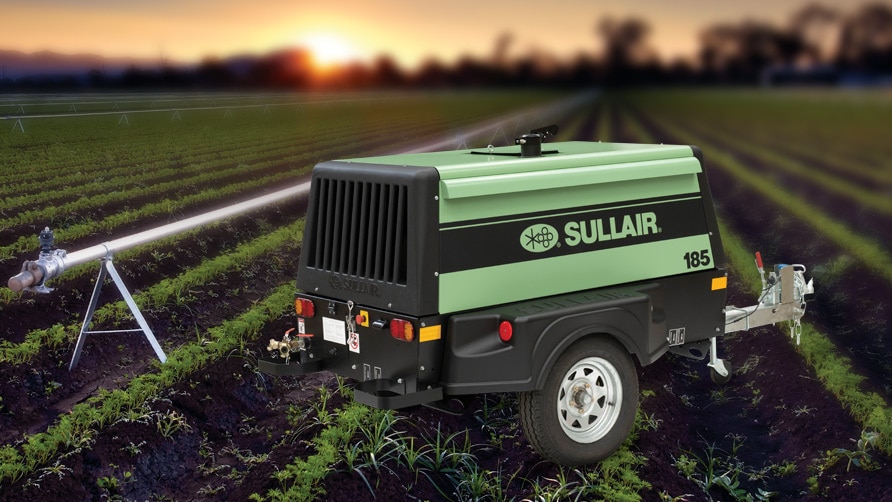
Ah, the sounds and smells of spring – singing birds, buzzing bees, freshly-cut grass, and a fresh burst of motivation to get things in order. As the colder, shorter days slip away, it’s time to make sure your portable air compressors are ready for the job site.
This is especially important if you live in a climate with long, cold winters and your equipment was stored or idle for months. Winter can be harsh, but with a little care, you can make sure your compressors are in tip-top shape for spring. This will help prevent unexpected breakdowns and extend their life. So, what does ‘preparing portable air compressors for spring’ entail? The usual care and maintenance of course, but also visual checks and safety inspections, which will benefit your equipment and operation.
Why you should prepare your equipment for Spring
With warmer and longer days, preparing your compressors is probably the last thing on your mind – but don’t neglect it. By preparing as soon as the weather starts to warm up, it’ll help ensure a smooth transition from one season to the next. There are several positive outcomes to preparing your air compressors for spring. Taking steps now can help prevent downtime and ensure the compressors remain reliable and ready to get to work with optimal performance. Paying attention to them now is an important step in protecting your investment. Portable diesel air compressors are vital to your work and if you take care of the compressors, they will take care of you. A few key steps at the start of the spring season, will help your compressors remain reliable and durable for the long-haul. Compressors that are well maintained throughout the year AND attended to at the change of season will also improve safety for those that use them – keep your employees safe by keeping up with maintenance. Neglecting it can lead to malfunctions or other hazards which can be easily avoided. Air compressors should be only operated by those who have been properly trained and delegated to do so.
How to prepare your compressors for Spring
Make sure your portable air compressor is on a level surface and has ample open space around it – at minimum about a metre – to conduct a comprehensive visual inspection.
Some key items on your checklist should include:
- Conducting a walk around – during this walk around check for any loose wires or connections, damaged piping, heat, or cold damage to parts, (which can appear as discolorations or the presence of a burnt smell), low fluids, low (or no) fuel, and loose or broken belts.
- Checking and/or changing filters – check air, oil, and fuel filters and replace as needed. Proper selection and use of filters will prevent many short and long-term problems with your air compressor. Air filters, for instance, can quickly build up debris and reduce the compressor’s efficiency.
- Changing the compressor oil, if needed – we recommend Sullair AWF® All Weather Fluid, which is one of the only fluids in the industry formulated specifically for use in portable air compressors. As its name indicates, it helps the compressor operate in all seasons, from extreme cold to extreme hot ambient conditions.
- Checking tyre pressure – a flat tyre won’t get you anywhere fast. Low temperatures in the winter can often mean low tyre pressure, so be sure the tyres are inflated to the proper psi, which can be found on the side wall of your tyre or in the compressor’s user manual.
- Checking coolers – if you work in dirty or dusty environments be sure to check and clean the coolers. Dirty or clogged up coolers and radiators can be a common cause for a machine to overheat and shutdown. Make sure they’re clean before your portables are sent out into the field.
- Checking ancillary components – do you plan to use ancillary components, such as pneumatic tools? These should be prepped, too. Check your tools and do some pre-starts and pre-checks to make sure everything is in working order.
- Keeping up with set frequency maintenance plans – set frequency maintenance plans may vary based on engine manufacturer, compressor size, climate, and day-to-day operating conditions, but Sullair generally recommends maintenance at 500 hours, 1000 hours, and 1500 hours. Typically, the compressor fluids and separator elements are both replaced every 1500 hours.
- Have a cleaning plan in place – be sure to clean and disinfect your portable air compressor to help prevent the spread of viruses, bacteria, and other transmissible microorganisms. Pay special attention to high-touch surface areas, such as buttons, controls, latches, knobs, gauges, access doors, handles, the drawbar, and valves. Use a standard sanitising wipe or cloth with household disinfectant to sanitise frequently touched areas either daily or each time a different operator uses the compressor.
Just as you may do a little spring cleaning in your house with the change of the season, you should also do some spring cleaning and maintenance on your air compressor. It will help ensure that, come spring, it’s not just birds chirping and bees buzzing, but your air compressor will be humming along on the job site, too.























